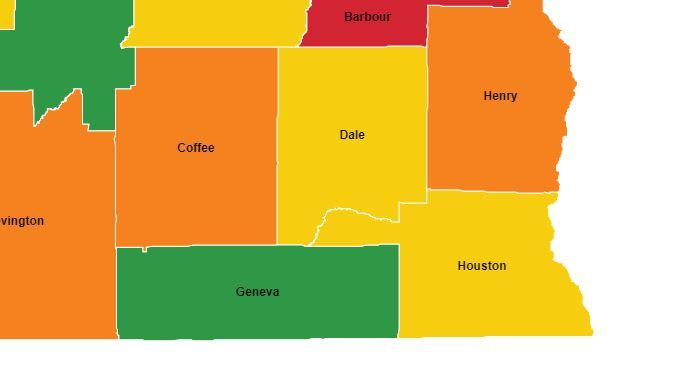DOTHAN, Ala. — The Alabama Department of Public Health deemed Coffee and Henry counties as high-risk for COVID-19, according to its new risk indicator dashboard.
The ADPH said county risk levels are determined by the county’s number of new cases per day.
“To better represent when the person could potentially spread the disease, the ‘case date’ is calculated based either on the date of specimen collection or symptom onset, depending on which date was first,” the risk indicator states. “These factors were chosen because they are not subject to reporting delays. If both specimen collection date and onset date are not available, case date is determined through either the date the test was entered into the lab system or the date the public health investigation of the case was initiated.”
To account for reporting fluctuations, the number of new daily cases is calculated by a three-day average.
Henry County’s three-day average increased from 7.7 to 13.6 from June 19 to June 20. Coffee County saw an increase from 8.9 to 9.1.
Both Henry and Coffee counties are not seeing a decline in the percentage of COVID-19 tests coming out positive, which is determined by whether the percentage is under 10 percent. From June 14 to June 20, Henry County had a positive percentage of 13.73 percent while Coffee had a percentage of 10.73 percent.
The state percentage during this time period was 10.9 percent.
However, not everything looks bad for the counties. Both are meeting their testing goals while seeing a decline in visits for COVID-19-like symptoms.
As for the rest of the Southeastern District, they have received the following ratings:
- Houston County — High Risk
- Geneva County — High Risk
- Barbour County — High Risk
- Coffee County — Moderate Risk
- Covington County — Moderate Risk
- Dale County — Moderate Risk
- Pike County — High Risk
- Henry County — High Risk
- Butler County — Moderate Risk
- Crenshaw County — Very High Risk
- What do the Risk Levels Mean?
Each risk level carries its own set of guidelines for residents to avoid getting sick from COVID-19 exposure.
The new risk indicator dashboard codes these levels in the following order: green, yellow, orange, and red.
Below are the guidelines for each risk level, straight from the ADPH:
Green – Low Risk
- Continue social distancing at work and wear face coverings at work when social distancing is impossible.
- Large gatherings and venues are allowed with increased hygiene measures, physical distancing, face coverings and symptom monitoring.
- Check for fever, coughing or other symptoms of COVID-19 before team sports or practices.
Stay home if sick.
- Places of worship are encouraged to consider social distancing, hygiene measures and face coverings.
- Children should follow hygiene measures, physical distancing, wear face coverings and monitoring for symptoms are encouraged for all group gatherings.
Yellow – Moderate Risk
- Avoid groups of more than 50 people.
- Keep 6-foot distances from people outside your household in theaters and other entertainment venues.
- Check for fever, coughing or other symptoms of COVID-19 before team games or practices.
- Hold online worship services if possible. When meeting in person, keep 6-foot distances between people of different households; consider holding more services for lower attendance, and more spacing between people.
- Children should keep a 6-foot distance from others outside their household, those with symptoms of COVID-19 should stay home from school or child care, limit interaction between children at playgrounds and other public places.
Orange – High Risk
- Continue social distancing at work, work from home when possible, and wear face coverings at work when social distancing is impossible.
- Limit out-of-state travel.
- Takeout, pickup or delivery from restaurants is encouraged rather than dining in.
- Maintain social distancing during outdoor recreation.
- Hold online workshop services if possible. When meeting in person, keep 6-foot distances between people of different households, consider holding more services for lower attendance, and more spacing between people at each service.
- Keep children away from in-person playdates or similar activities outside of the school setting if avoidable and do not allow children on public playgrounds.
Red – Very High Risk
- Wear face coverings where other social distancing measures are difficult to maintain.
- Even when visiting family or friends, wear face coverings when within 6 feet of people outside your household.
- Avoid all unnecessary travel. If you must travel, avoid crowded areas if possible.
- Telework if possible. If not, maintain a 6-foot distance from others and wear face coverings at work.
- Takeout, pickup or delivery from restaurants is strongly encouraged rather than dining in.
- Avoid groups of more than 20 people.
- Avoid unnecessary visits to hospitals, nursing homes or other residential care facilities.
- Worship online or keep 6-foot distances between people of different households.
- Children with COVID-19 should stay home or be sent home for school or child care if showing symptoms. Limit public interaction between children and do not allow children on public playgrounds.
In a Tuesday press conference announcing the extended Safer At Home order, Harris said Alabamians do not need to be letting their guard down.
“We are committed to protecting the health and safety of Alabamians by giving guidance based on the best science and public health practices available,” State Health Officer Dr. Scott Harris wrote said in a press release later that day. “We will continue to maintain and update the statewide data and metrics and provide consistent localized data for use in local decision-making for reopening plans.”






